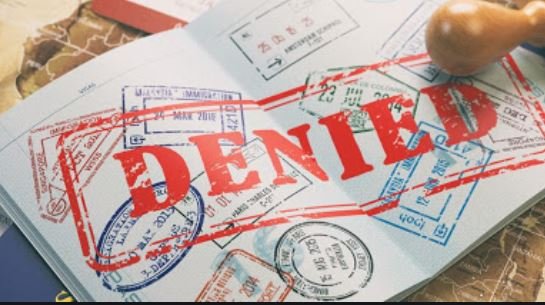UAE’s Bold Move: Visa Ban Affects Nine Countries. What’s Happening?
Recently, the UAE shook things up by changing the visitor experience. There is a visa ban imposed on nine countries, and prospective tourists and workers will no longer be able to apply for a visa status to visit the UAE. If you had aspirations to wander the vibrant souks of Dubai, take photographs at the brink of the Burj Khalifa, or work in one of the bubbling markets of Abu Dhabi, this could complicate your plans. This decision has raised questions as to who is on the list, why this is happening, and the future of travel and work for those impacted.
If you are from one of these countries or planning a trip to the UAE, no need to worry; this article will help you understand the situation. In this post, we will outline the banned countries, outline the reasons for each restriction, and provide you with relevant information to help you navigate the next steps.
The Nine Countries Under the UAE Visa Ban
This is a quick outline of the countries whose citizens are not permitted to obtain new tourist or work visas at the moment and until further notice from the UAE, including Afghanistan, Yemen, Somalia, Libya, Lebanon, Bangladesh, Cameroon, Sudan, and Uganda. The restrictions began as a component of the UAE’s 2026 visa plan and paused the acceptance of new applications while allowing those presently holding visas to continue travelling at their leisure. It is not a total stoppage of travel from these nations, just a very clear indication of “not right now”.
Now, moving toward the details. For each country, this article will explore some of the key factors that led to this determination. These bans were not arbitrarily decided; there are several real-world issues contributing to the decision, such as security issues, tenuous diplomatic relationships, and possible health issues stemming from the pandemic.
1. Afghanistan: A Matrix of Security Threats and Instability
Afghanistan leads this list, and it shouldn’t come as a surprise. Since the Taliban returned to office a few years ago, the nation has become a hotbed of world anxiety. The UAE’s top gripe here is terrorism threats, considering forces such as ISIS-K that have local roots and might slip across borders. Security analyst reports indicate an uptick in attempted entries tied to militant networks, prompting the UAE to toughen up. Throw in the chaos from the constant fighting, and you’ve got yourself a powder keg where checking identities becomes iffy. Diplomatic chill is involved too; the UAE doesn’t want any connections that would suck them into the perpetual chaos of Afghanistan. It’s all about maintaining that stable atmosphere the Emirates have so scrupulously cultivated.
2. Yemen: Instigating Regional Tensions and Proxy Wars
Yemen’s situation could be described as a page from a geopolitical thriller. The Saudi-led coalition fighting against the Houthis in a civil war has reached a boiling point that has threatened to engulf the Gulf region. The UAE was the first country to withdraw all its soldiers from Yemen, but is likely also weighing its regional stability and level of danger, having been recently targeted by drone strikes as well as missiles aimed at its neighbors. In the eyes of the UAE authorities, all of these risks create an association with their own population of Yemeni nationals, suggesting that there is a greater risk of espionage or sabotage, especially due to the Houthis’ Iranian connections and their alliances with enemies of the Houthis. Additionally, issues regarding forged passports from war zones, such as Yemen, can create challenges for legitimate travelers and make scrutiny of Yemeni travelers more problematic. Ultimately, this travel ban seeks to insulate the UAE from entanglement with the civil war and such risk, and allow the country to continue pursuing stability and safety within the borders of the state and the Gulf region.
3. Somalia: Fending off Piracy, Militancy, and Permeable Borders
Somalia’s got that Wild West reputation in the Horn of Africa, and the UAE’s not interested in buying into the adventure. Al-Shabaab’s militant operations give security types sleepless nights; the organization’s got a history of exporting instability, including plots that extend to Gulf states. And then there’s piracy off the coast, which targets shipping lanes the UAE depends on for commerce. The prohibition is due to fears of uncontrolled migration tides across volatile borders, where criminal gangs make a killing and counterfeit passports are as available as sand. Health considerations linger as well, with refugee camp outbreaks raising concerns after COVID. Bottom line, Somalia’s instability is a no-go for loose visa stamps; the UAE wants no cracks in its system.
4. Libya: Whispers of Civil War and Militia Fighting
Libya’s been broken since Gaddafi’s demise, and it’s left a mess of militias and oil rivalries that the UAE can’t avoid. They’ve got an interest in the game, supporting factions within the east, so this ban has to do with those rivalries directly, avoiding any influx that would tip balances or introduce spies. Security-wise, the nation is saturated with arms trafficking and ISIS pockets, providing a pipeline for threats to potentially find their way into Dubai. Document forgery is rampant in the midst of the mayhem, as officials are unable to screen applicants with any semblance of reliability. It’s a strategic gamble to avoid importing that powder keg from Libya and guaranteeing the UAE doesn’t.
5. Lebanon: Frayed Relations in The Face of Economic Collapse and Hezbollah Overhang
Lebanon’s deterioration into crisis comes hard, but the UAE is setting a line. Hezbollah’s control, viewed by most in the Gulf as a terror wild card, is the grand elephant here; Hezbollah’s cross-border activities and Iranian connections unsettle UAE leaders. Financial collapse has fueled waves of desperate emigration, many with questionable paperwork that cries fraud risk. Diplomatic crises, such as Syrian refugee feuds and interference in the region, further fuel the UAE’s cuts in aid relations, partly for these squabbles. Health issues from packed camps remain, which makes the combination too dangerous. This prohibition is about establishing a line, allowing Lebanon to get its affairs in order without the UAE paying for it.
6. Bangladesh: Addressing Overstay Epidemics and Labor Waves
Bangladesh generates significant revenue for the UAE, home to over a million people sending billions of remittances. However, with the country’s overstaying rates and influx of undocumented workers, the resources are bogged down. The ban focuses on these reported overstays cases, with allegations of fake documentation and people trafficking benefiting from relaxed regulations. Security has taken a backseat, but migration surges have stressed resources like housing and labor markets. The health protocols post-COVID have highlighted gaps in screening, and diplomatic outreach has not resolved the flow. It’s basically the UAE saying, “We love the activity, but clean up the paperwork first!”
7. Cameroon: Dealing with Separatist Violence and Health Crises
Cameroon has ongoing problems that compel the UAE to hit pause. Anglophone separatist conflict in the West has led to instability, with some armed groups operating across national borders and smuggling routes into Cameroon. This feeds into security concerns and increased concerns that radical elements could exploit migration flows. As it pertains to health references, outbreaks like cholera in conflict zones and vaccination coverage are reminiscent of fears during the COVID public health emergency, and complicate entry checks. Forged identification documents proliferate in fractured states like this, which lowers confidence in applications for humanitarian assistance programs.
8. Sudan: Civil War Fallout and Refugee Pressures
Sudan has recently devolved into active civil war, with competing generals turning cities to rubble. For the UAE, the reasoning hits on that raw nerve: large outflows of refugees carry unvetted entrants, including militants, into the mix. Considering the way they play diplomacy, the UAE mediated the peace discussions to credit, but only backed one of the combatants, creating confusion and souring bilateral ties in the region. There is no integrity in the document, with war-torn countries giving rise to tons of fakes. Further, with health risks from displaced camps, and after seeing the world’s exposure to pandemic vulnerabilities, it reminds everyone that these are true threats to life. The move was one of self-preservation and stopping Sudan from bursting before it spills over the Gulf States.
9. Uganda: Corruption Scandals and Migration Mismanagement
Uganda rounds out the list for its own share of migraine. Ugandan passport issuance corruption fueled a swarm of fake passports into the UAE application process, which has all but undone the vetting system. On top of that, Uganda is dealing with irregular labor and overstays, where some workers find themselves in the hands of exploitative networks. The national security picture goes back to the regional unrest and spillover from conflicts in the eastern part of the Congo, not to mention whether any militant groups are playing roles in Uganda. The health monitoring picture is difficult, particularly with variable responses to outbreaks. The ban has shown the point, time to clean things out before they get the tap turned on again.
Conclusion
This visa ban is a major change, ruining the dreams of UAE adventures for individuals and families from each of the nine countries affected. This isn’t necessarily a minor policy change; it’s a policy that signals something much bigger in regard to the UAE ramping up its focus on security, safety, and control over its borders. Each ban has specific reasons, where all nine countries demonstrate the relationship between war-torn nations, pressure from migration influx, and the UAE’s aim to protect its golden reputation, among concerns about international pressure. For travelers, workers, or families caught up with the ban, it is a hard thing to deal with, but it is not the end of the world. Keep checking with official channels of information because things are supposed to change once a new agreement is reached, at least as far as visa rules are implemented.








